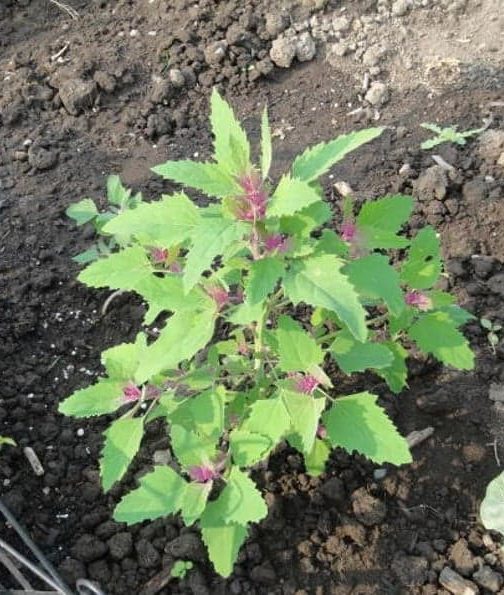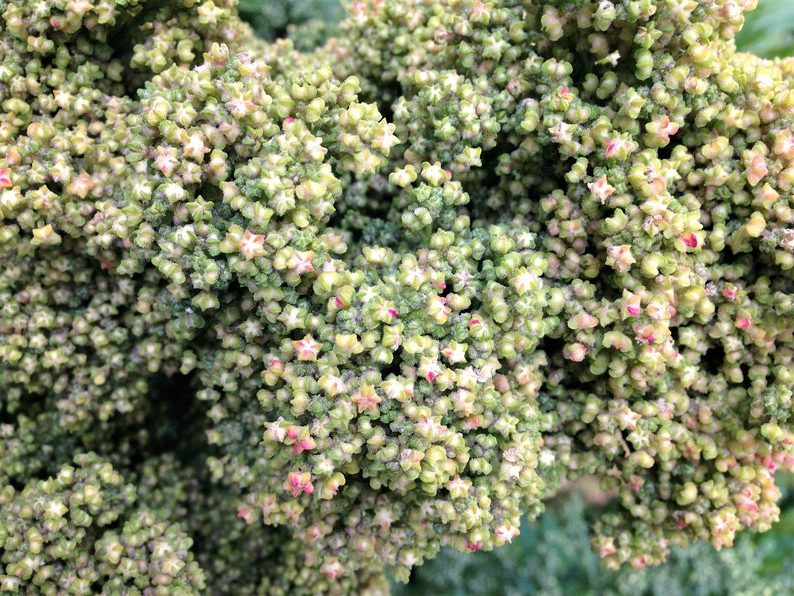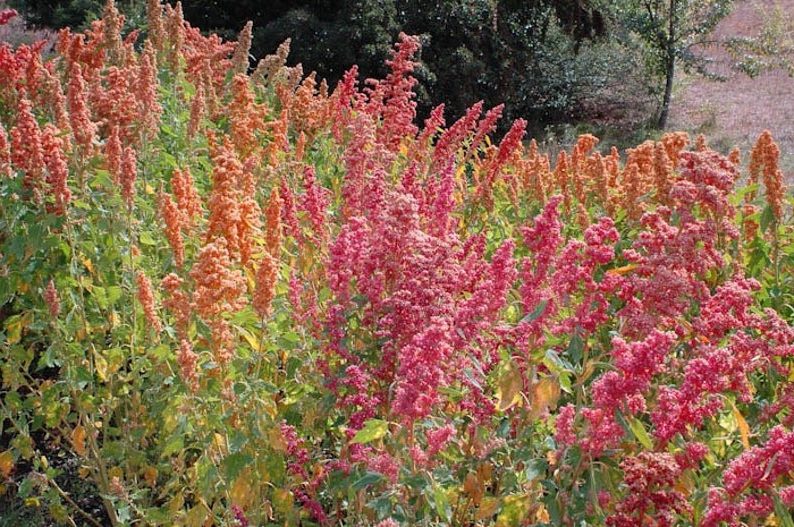Growing a quinoa plant can be surprisingly easy, especially after you get it going. After harvesting, you can enjoy it in salads, as a side dish or meal. It’s easy to grow for beginner gardeners and is drought tolerant making it low maintenance.
Quinoa flowers are bright and will bloom in shades of orange, yellow, or red. They are productive, colorful additions to gardens and can be part of an edible landscape.
Quinoa is a warm season crop. You’ll need to live in an area warm enough so it will have 3 – 4 months to grow. They do well with a minimum of 6 hours of direct sunlight per day.
You can grow quinoa from store-bought seeds. They are quick to germinate, taking 2 – 4 days.
Keep reading for everything to know about growing quinoa and harvesting the edible seed.
What is a Quinoa Plant?
The quinoa plant is a grain crop. It’s part of the amaranth family and is an herbaceous plant. It’s scientific name is Chenopodium quinoa. It’s a flowering annual plant in the Amaranthaceae family.
Quinoa plants contain small edible seeds. People eat the seeds; this is what you’ll find in stores. When you grow quinoa, you can also eat the leaves. The leaves are similar to spinach, so you can make the most of the entire plant.
In most cases, quinoa self-pollinates. However, the plant can cross-pollinate with other species, like lamb’s quarter. It does very well in dry conditions, but it needs some water to thrive.
Quinoa plants can grow to be 6- 7 feet tall and have a central stem. The stem is woody. They are dicotyledonous (also called dicot) which means they have a pair of leaves in the embryo of the seed.
It’s related to beetroot, spinach and chard. To pronounce it, say KEEN-wah.
When growing at home, rinse the seeds thoroughly to remove the saponin. While it works in nature to deter pests, for humans, it can cause digestive issues. It tastes bitter and a bit like soap.
How to Grow Quinoa
Being able to grow quinoa means you don’t have to find it at a grocery store. It’s also a way to include a nutritious grain into your garden and work toward self-sufficiency. You can control how much you plant and grow, and you can enjoy the seeds and leaves in many dishes.
To make most of your crop and cultivate as much as possible, consider the following to grow a quinoa plant.
Quinoa flowers are self-pollinating and can also be insect-pollinated and wind-pollinated.

Where Does Quinoa Grow in the World
Most of the world’s quinoa farming in Bolivia. It’s is a warm-season plant, so you can grow it in areas with warm temperatures.
You can grow it in North America. Quinoa growing zones are USDA hardiness zones 4 – 10. They are tolerant to frost after the plants are established.
Within these growing zones, you’ll need to have a warm season that spans 90 – 120 days.
When to Plant
A quinoa plant will thrive where there is full sun and when the temperatures remain under 90 degrees F (32 degrees C).
Temperatures higher than 95 degrees F can harm the plant. If you live in a hot climate, you’ll need to avoid growing quinoa the hottest months.
Ideally, soil temperatures should be between 65 and 75℉ (18 and 24℃). Use a thermometer to check the soil temperature. As long as it’s above 60℉ (15℃), the seeds will be able to germinate and take root.
Unfortunately, it won’t always germinate if the soil is significantly warmer. Because of that, you may want to check the soil earlier so that you don’t miss the critical period.
Because of the temperature requirements, the right time to plant quinoa depends on where you live. If you live a bit farther south, you can plant the seed as early as late April. However, you may need to wait until May or June if you live farther north.
Full Sun
No matter where you live, you should plant quinoa in a place with full sun exposure. At a minimum, a quinoa plant needs six hours of direct sunlight each day.
Where to Grow
You can plant quinoa in pots and containers, in garden beds, and directly in the ground.
Soil
Quinoa plants do well in sandy and saline soil. They can also grow in marginal soil and even poor soil. There aren’t many plants that grow well in nutrient-poor soil so consider this if that’s your situtation.
You can use a soil test kit to test the soil pH. It does well in slightly acidic to alkaline soils from 6 – 8.5. They are able to shed excess salt. You can mix in compost or buy bags of soil with compost if you choose.
Planting
When you’re ready to plant quinoa, consider the steps for the best chance of growing. Follow these steps when planting quinoa seeds, no matter where you live.
You can buy non-GMO quinoa seeds or use untreated seeds from the grocery store. Depending where you live and the season, you may need to start quinoa from seed indoors and then transplant outdoors.
- Make sure the soil is loose.
- Prepare the rows and spots for the quinoa so there is 10 – 12 inches of space between seeds.
- Plant two or three seeds in each spot.
- Plant seeds 1/4 inch deep.
- Cover with soil.
- Once areas sprout, thin them so that one plant remains.
- If areas don’t sprout, replant seeds within the next week.
Fortunately, you don’t need to do a ton of maintenance at this stage. However, you should make sure the plants have water.
If you have a lot of seeds that sprout, it will be tempting to grow them all. However, once the seeds germinate, you should snip the smaller one and keep the stronger one.
Germination occurs within 7 days.
Watering
The quinoa plant can do well in dry conditions, so you should only have to water it 2 – 3 times per month once it’s established. Factor in rainfall as well.
However, you should monitor the soil to keep it moist, especially at the beginning.
After the plant germinates, you only need to water it when the soil gets dry. You shouldn’t keep the soil moist all of the time because that can lead to waterlogging and other issues.
Water less frequently once the flowers have formed. This plant does best in dry conditions and are drought tolerant and fully hardy.
Because of the changing water conditions, make sure to use soil that offers good drainage. That way, the soil won’t hold excess water.

As long as you have good growing conditions, the plant should grow fairly independently. Consider a few essential maintenance steps to take each week. That way, you can increase the chances of your quinoa plant surviving.
Weeding
Eliminating weeds will give the quinoa more room to grow, which is especially important as the plant starts to germinate. However, the initial signs of quinoa can look a lot like lamb’s quarters and other weeds.
Growing in a line can help you avoid pulling it out when weeding. Make sure you remember the line so that you can weed around it. Then, you can get rid of other plants in the area so that the plants have space to take root.
While weeding isn’t as important later. It’s likely the quinoa plant will block their sun, and they won’t survive. A quinoa plant can grow to be six and a half feet tall.
You will still need to get rid of lamb’s quarters due to cross-pollination with quinoa. It may affect the harvest.
Pests
One benefit of quinoa farming is that it’s more resistant to pests than other plants. The seeds have a bitter layer on the outside called saponin that helps deter insects and other pests.
However, caterpillars can focus on the leaves. If you notice a caterpillar or two eating or living on the leaves, you can pull them off yourself. Use a glove or your bare hand and grab the caterpillar.
If there are a lot, consider using diatomaceous earth. Sprinkle it over and around the plant to keep caterpillars from coming to the plant.
Another pest is aphids. Deer will also eat the plant and seeds.
Quinoa Plant Disease
Because of quinoa’s hardiness, it can also resist diseases more easily than other pests. If you water the plant the right amount, you shouldn’t have to worry about the plant getting sick.
Waterlogging and a lot of rain can cause mold or mildew. However, giving the soil time to dry before you water it can help avoid this.
And while some insects can transmit diseases from beets or spinach, the viruses aren’t usually serious. The quinoa can withstand the effects without much change in the amount of quinoa you can harvest.
While diseases can affect any plant, quinoa can manage them well. As long as you keep up with your gardening routine, it should keep growing.
Harvesting Quinoa
After a few months of growing, it’s time for quinoa cultivation. Harvesting quinoa is easy.
As far as yield, expect to harvest 1 – 2 ounces (30g – 60g) of seeds per quinoa plant. To grow one cup of quinoa, plant a minimum of eight plants.
Before you start harvesting these edible seeds, consider a few factors to make sure the crop is ready.
When to Harvest Quinoa
It’s time to harvest quinoa seeds after the leaves fall off. Your plant will only have the dry seed heads left.
Fortunately, you don’t need to harvest the seeds right away when this happens. Leaving them on to dry longer can help. However, cultivate quinoa before it rains so they don’t germinate on the plant.
To overcome this, you can harvest quinoa before the seeds are completely dry. To tell, press seeds with your thumbnail. If they dent slightly, they are ready to harvest.
Using visual cues to tell when it’s time to harvest the seeds means you don’t need to know exactly when you planted it. However, the days to maturity for quinoa is 90 to 120 days.
The leaves are edible too. Before all the leaves fall, you can harvest them to use in a salad or as an alternative to spinach. If you want to spruce up your greens, quinoa leaves are an excellent option.
How to Harvest Quinoa
Once you verify the temperature and climate are optimal for harvesting quinoa, you can start the process. You’ll need a glove and a container to collect the seeds.
- Place the glove on your hand.
- Grab a container and hold it below the stalk you’re going to harvest.
- Using your gloved hand to strip the seeds up and off the stalk.
- Put the seeds in the container.
- Repeat for each stalk of quinoa.
Harvesting quinoa is relatively quick and easy, and you can cultivate multiple stocks in one session. Be sure to rinse homegrown quinoa thoroughly before cooking.
Then, you can use the quinoa in your favorite recipes or store it for later.
Temperature
If the outside temperature is extremely warm, it can affect the fruit set. This can happen when daytime temperatures are extreme or if nighttime temperatures are warmer than average.
However, it can withstand a frost or two down to 20 degrees F once established as long as the soil remains dry. Wait a day or so after a frost before you harvest the quinoa.
Rain
Along with temperature, the amount of rain and water in the area can affect when you should harvest quinoa. If you have a lot of rain, you should use your fingernail to indent one of the seeds.
When the seed barely indents, it’s safe to harvest. However, dry seeds are ideal for harvesting because you won’t have to let them dry before storing them.
If you’re trying to decide if you should harvest the quinoa today or wait, check the forecast. Do any harvesting that you can before a rainstorm so that you can keep the seeds from getting wet and germinating.
Drying Quinoa Seeds
After you harvest quinoa seeds, and rinse them well, let them dry. Choose a sunny day without rain.
Find a spot with a good amount of sun exposure and place a newspaper or screen there. You can also spread them in a baking pan. Spread the seeds out so that they’re one layer. If you have more seeds than drying space, you may need to find another area to dry the rest.
Let the seeds sit in the sun for a day or two and check on them until they’re dry. Then, you can put the seeds in an airtight container and store them for up to six months or until you want to use them.
Varieties of Quinoa
When choosing seeds, these are the varieties you will find:
- Brightest Brilliant
- Red Head
- Royal White
- Cherry Vanilla
- Taiwanese
Brightest Brilliant is often easiest to find. Flowers can be in shades of yellow, orange, red, green, and white. You’ll see everything from light pink to dark burgundy.
Choose non-GMO and organic seeds when possible.
Benefits of Quinoa
If you’re trying to decide if growing the quinoa plant is worth it, consider some facts and benefits. Then, you can make sure you will get the most of your time and harvest.
Easy to Grow
Growing quinoa is an excellent option because it can survive in many conditions. Even if you don’t plan to eat it, this grain can be a great choice for new gardeners. You don’t need to worry about having the perfect growing spot or the optimal climate.
Everything to know about growing successfully can only make your quinoa harvest better. Then, you can enjoy the fruits of your labor.
While you may need a lot of room to grow multiple stalks, it can deal with dry spells, pests, and other issues. You don’t need to maintain the plants like you do other plants in the garden.
Size and Color
The quinoa plant can be as tall as 6.6 feet, and other stalks tend to be at least 3.3 feet tall. That size makes it easy to spot, and it can look good in any garden.
And while seeds may not change colors, the other parts of the plant do. The woody stem can be red, green, or purple in color. Quinoa leaves start out green, but they can change color as they get older.
They are a productive plant and add to landscaping with the colorful flowers.
Nutritional Content
The plants will produce edible seeds that contain an excellent source of plant-based protein and fiber. It’s a complete protein with a high protein content. It contains fiber, manganese, boron, as well as essential amino acids.
Because of that, it’s also more filling than some foods, so it can keep you from getting hungry throughout the day. It’s also more nutritious in other areas as it’s a good source of calcium and magnesium.
The seed is a great gluten free, vegan option that can help you get the nutrients you need. You don’t need to consume dairy products or other grains. There are many tasty quinoa recipes to choose from to keep it interesting.
The leaves are also nutritious adding to the health benefit of this plant.
Versatile
Once you finish growing the quinoa plant, you can use it in many ways. For one, you can use the quinoa leaves before the growing season is over. They make a great alternative to spinach, and you can use them to make quinoa salad or other dishes.
Sprinkle with cinnamon, add nuts and fruit and enjoy it for breakfast.
You can use them as flakes, grains, or flour in recipes. They work in many ways to enhance meals. And since the seed doesn’t contain gluten, it’s considered naturally gluten free and an excellent alternative for people who can’t consume wheat.
You can also sprout quinoa seeds. This grain is a food you can store long-term.
History of Quinoa
It originates in the Andes Mountains of South America, in Bolivia, Peru and Chile. While it may look like a grain, it’s a seed, and it’s relatively easy to grow. People have been growing and eating quinoa for thousands of years. It’s easy to harvest by hand or using a combine.
In the 1500s, it fell out of favor when the Spanish explorers arrived. One explorer named Francisco Pizarro destroyed many quinoa fields to try and destroy Incan culture.
Fortunately, some survived high up in the mountains. In the 1970s, people were able to start growing it again and make it popular.
Will You Grow Quinoa?
It’s an excellent food, and the quinoa plant is a great plant that can survive almost anything. Whether you’re new to gardening or want to branch out, you can grow quinoa plants.
While many people think of growing fruits and vegetables, this a good addition to a garden and a versatile food crop. It has a high protein content, is gluten free and can grow in marginal soil.
You can use the seeds in your favorite dishes or new recipes. Be sure to reserve some to plant again the following season. From growing to harvesting quinoa, it’s versatile and a good choice for many people.
Like many crops, it’s easy to grow. Quinoa plants also provide the benefit of adding color to gardens and outdoor spaces.
Learn about planting the easiest vegetables to grow

